绿色化工研究进展.ppt
- 格式:ppt
- 大小:175.01 KB
- 文档页数:3



绿色化工技术在化学工程与工艺中的应用研究绿色化工技术是指以环境友好、资源节约和高效利用为原则,致力于绿色化学产品的生产及加工的一种化学工艺技术。
绿色化工技术已经成为当今化学工程与工艺领域的研究热点,其在实际应用中具有广阔的前景和重要的经济意义。
本文将从绿色化工技术的背景和意义、在化学工程与工艺中的应用研究以及存在的问题和展望等方面进行阐述。
一、绿色化工技术的背景和意义随着人类对环境保护和资源利用的重视程度不断提高,传统的化工生产模式已经不能满足当今社会的需求。
环境污染、资源浪费和能源消耗等问题成为困扰人类的主要障碍。
作为应对这些挑战的技术手段之一,绿色化工技术应运而生。
绿色化工技术以实现绿色生产和可持续发展为目标,注重降低环境影响、节约资源和提高产品质量。
1. 绿色催化剂的研发与应用以金属有机框架材料(MOF)等为代表的新型催化剂已经成为绿色催化剂研究的热点。
MOF是一类由金属离子和有机配体组成的多孔结构材料,具有独特的表面积和孔径特征,能够提高催化反应的效率和选择性。
通过合理设计和构建MOF的结构,可以实现对酸碱性、导电性和孔隙性等性质的调控,从而实现对催化反应的精准控制。
MOF在有机合成、催化转化和环境净化等方面都表现出了良好的应用潜力。
除了MOF,生物催化剂也是绿色催化剂中的一大亮点。
生物催化剂以微生物和酶为代表,具有高效、高选择性和可再生的特点,已经成为化工生产中的重要催化剂。
通过遗传工程和表面修饰等手段,可以提高生物催化剂的稳定性和活性,实现对复杂有机废水的生物降解和有机合成反应的催化转化。
2. 生物技术在绿色化工技术中的应用生物技术是绿色化工技术中的另一大重要组成部分,主要包括生物法处理废水、生物质能源生产和生物基合成材料等方面。
生物技术可以利用微生物、酶和甲烷发酵等手段,实现对有机废水、废水和固体废弃物的高效处理和资源化利用。
生物技术还可以通过生物转化和发酵等过程,生产生物柴油、生物醇和生物聚合物等生物基产品,为化学工程与工艺提供了可替代的绿色合成方案。
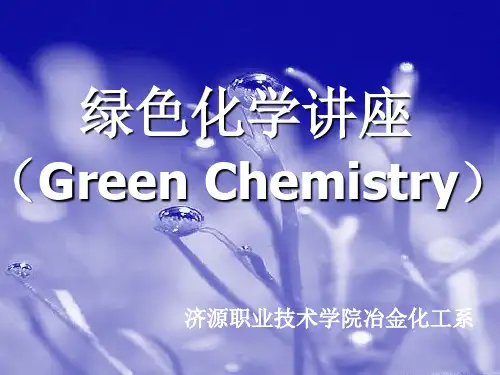
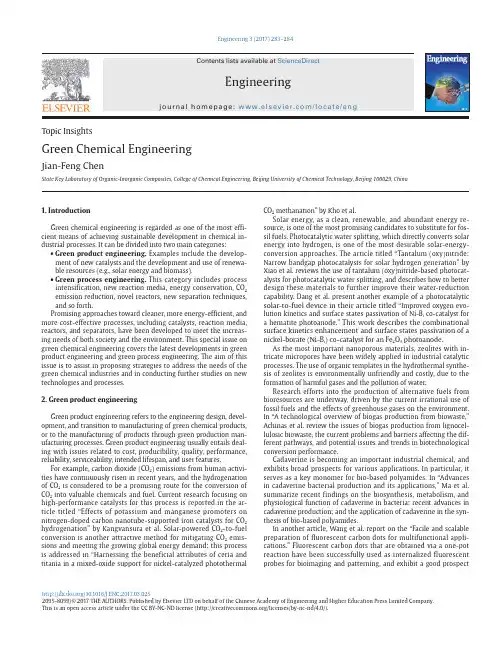
Engineering 3 (2017) 283–284/10.1016/J.ENG.2017.03.0252095-8099/© 2017 THE AUTHORS. Published by Elsevier LTD on behalf of the Chinese Academy of Engineering and Higher Education Press Limited Company.This is an open access article under the CC BY-NC-ND license (/licenses/by-nc-nd/4.0/).Topic InsightsGreen Chemical EngineeringJian-Feng ChenState Key Laboratory of Organic-Inorganic Composites, College of Chemical Engineering, Beijing University of Chemical Technology, Beijing 100029, China1. IntroductionGreen chemical engineering is regarded as one of the most effi-cient means of achieving sustainable development in chemical in-dustrial processes. It can be divided into two main categories:• Green product engineering. Examples include the develop-ment of new catalysts and the development and use of renewa-ble resources (e.g., solar energy and biomass).• Green process engineering. This category includes process intensification, new reaction media, energy conservation, CO 2 emission reduction, novel reactors, new separation techniques, and so forth.Promising approaches toward cleaner, more energy-efficient, and more cost-effective processes, including catalysts, reaction media, reactors, and separators, have been developed to meet the increas-ing needs of both society and the environment. This special issue on green chemical engineering covers the latest developments in green product engineering and green process engineering. The aim of this issue is to assist in proposing strategies to address the needs of the green chemical industries and in conducting further studies on new technologies and processes.2. Green product engineeringGreen product engineering refers to the engineering design, devel-opment, and transition to manufacturing of green chemical products, or to the manufacturing of products through green production man-ufacturing processes. Green product engineering usually entails deal-ing with issues related to cost, producibility, quality, performance, reliability, serviceability, intended lifespan, and user features.For example, carbon dioxide (CO 2) emissions from human activi-ties have continuously risen in recent years, and the hydrogenation of CO 2 is considered to be a promising route for the conversion of CO 2 into valuable chemicals and fuel. Current research focusing on high-performance catalysts for this process is reported in the ar-ticle titled “Effects of potassium and manganese promoters on nitrogen-doped carbon nanotube-supported iron catalysts for CO 2 hydrogenation” by Kangvansura et al. Solar-powered CO 2-to-fuel conversion is another attractive method for mitigating CO 2 emis-sions and meeting the growing global energy demand; this process is addressed in “Harnessing the beneficial attributes of ceria and titania in a mixed-oxide support for nickel-catalyzed photothermal CO 2 methanation” by Kho et al.Solar energy, as a clean, renewable, and abundant energy re-source, is one of the most promising candidates to substitute for fos-sil fuels. Photocatalytic water splitting, which directly converts solar energy into hydrogen, is one of the most desirable solar-energy- conversion approaches. The article titled “Tantalum (oxy)nitride: Narrow bandgap photocatalysts for solar hydrogen generation” by Xiao et al. reviews the use of tantalum (oxy)nitride-based photocat-alysts for photocatalytic water splitting, and describes how to better design these materials to further improve their water-reduction capability. Dang et al. present another example of a photocatalytic solar-to-fuel device in their article titled “Improved oxygen evo-lution kinetics and surface states passivation of Ni-B i co-catalyst for a hematite photoanode.” This work describes the combinational surface kinetics enhancement and surface states passivation of a nickel-borate (Ni-B i ) co-catalyst for an Fe 2O 3 photoanode.As the most important nanoporous materials, zeolites with in-tricate micropores have been widely applied in industrial catalytic processes. The use of organic templates in the hydrothermal synthe-sis of zeolites is environmentally unfriendly and costly, due to the formation of harmful gases and the pollution of water.Research efforts into the production of alternative fuels from bioresources are underway, driven by the current irrational use of fossil fuels and the effects of greenhouse gases on the environment. In “A technological overview of biogas production from biowaste,” Achinas et al. review the issues of biogas production from lignocel-lulosic biowaste, the current problems and barriers affecting the dif-ferent pathways, and potential issues and trends in biotechnological conversion performance.Cadaverine is becoming an important industrial chemical, and exhibits broad prospects for various applications. In particular, it serves as a key monomer for bio-based polyamides. In “Advances in cadaverine bacterial production and its applications,” Ma et al. summarize recent findings on the biosynthesis, metabolism, and physiological function of cadaverine in bacteria; recent advances in cadaverine production; and the application of cadaverine in the syn-thesis of bio-based polyamides.In another article, Wang et al. report on the “Facile and scalable preparation of fluorescent carbon dots for multifunctional appli-cations.” Fluorescent carbon dots that are obtained via a one-pot reaction have been successfully used as internalized fluorescentprobes for bioimaging and patterning, and exhibit a good prospectContents lists available at ScienceDirectj our na l h om epa ge: w w /locate/engEngineering284J.-F. Chen / Engineering 3 (2017) 283–284for solid-state fluorescent sensing, security labeling, and wearable optoelectronics.3. Green process engineeringGreen process engineering focuses on the design, operation, control, optimization, and intensification of chemical, physical, and biological processes for sustainable development. Researchers in this field strive to solve key scientific problems in resource-efficient conversion and process upgrades in order to create innovative and original technology platforms for the development of clean industri-al processes.Caprolactam, the monomer for the nylon-6 fiber and for engi-neering plastics, is an important basic organic chemical. A green caprolactam production technology has been successfully developed in China, and has a global market share that exceeds 50%. Zong et al. present a review of this technology in “Green production technology of the monomer of nylon-6: Caprolactam.”Photosynthetic microorganisms are important bioresources for the production of desirable and environmentally benign products, and photobioreactors play an important role in these processes. The article titled “Design of photobioreactors for mass cultivation of photosynthetic organisms” by Huang et al. presents a critical over-view of the key parameters in photobioreactor design, which include light, mixing, mass transfer, temperature, pH, capital, and operating costs. Bioreactor lifespan and the costs of cleaning and temperature control are also analyzed in terms of commercial exploitation.Wastewater treatment is a process that is vital for the protec-tion of both the environment and human health. In “Fluidized-bed bioreactor applications for biological wastewater treatment: A review of research and developments,” Nelson et al. summarize the circulating fluidized-bed bioreactor technology for treating wastewater. The excellent mixing and mass transfer characteristics that are inherent to fluidization make this process very effective in treating both municipal and industrial wastewater. In “Optimi-zation, kinetics, and equilibrium studies on the removal of lead(II) from an aqueous solution using banana pseudostem as an adsor-bent,” Bagali et al. attempt to utilize banana pseudostem powder as an adsorbent material to remove lead(II) from an aqueous solu-tion in a batch mode.Municipal solid waste (MSW) has become a major environmental concern across the globe due to its huge volume and severe environ-mental pollution. The study titled “Thermodynamic analysis of the gasification of municipal solid waste” by Xu et al. reports the gasifi-cation performance of MSW by thermodynamic analysis for differ-ent types of MSWs across a large range of temperature and steam-to-MSW ratio.Improving the efficiency of reaction and separation processes and reducing the energy consumption of such processes are es-sential to easing energy, resource, and environmental problems. In “Membrane engineering for green process engineering,” Macedonio and Drioli present an overview of membrane applications and their perspectives in strategic industrial sectors such as water treatment, energy production, and raw materials extraction. Regarding more traditional crystallization processes, in “Recent developments in the crystallization process: Toward the pharmaceutical industry,” Gao et al. review crystal engineering and crystallization process design and control, and present an overview of new types of crystals such as co-crystals, polymorphs, and solvates. Finally, in the review titled “Progress of pharmaceutical continuous crystallization,” Zhang et al. thoroughly summarize the advantages and disadvantages of differ-ent types of continuous crystallization processes.Engineering 2 (2016) xxx–xxxTopic InsightsContents lists available at ScienceDirectj our na l h om epa ge: w w /locate/engEngineering绿色化工陈建峰State Key Laboratory of Organic-Inorganic Composites, College of Chemical Engineering, Beijing University of Chemical Technology, Beijing 100029, China1. 引言绿色化工是化学工业实现可持续发展的有效途径,主要可分为两大发展方向:• 绿色产品工程,如开发新型催化剂,或者开发利用可再生资源(太阳能、生物质能等)产品;• 绿色过程工程,包括化工过程强化、新型反应介质、节能降耗、二氧化碳减排、新型反应器和新型分离等过程技术。

绿色化学合成技术在化工领域中的应用研究【绿色化学合成技术在化工领域中的应用研究】第一章绿色化学合成技术的概述绿色化学合成技术是一种注重环境友好、资源高效利用的化学合成策略。
它强调减少或消除有害物质的生成和使用,降低废物排放以及利用可再生能源等方面的原则。
绿色化学合成技术在化工领域中的应用日益广泛,极大地推动了化工产业的可持续发展。
第二章绿色溶剂的应用研究传统的化工合成过程中常使用的溶剂往往对环境和人体健康有一定的危害。
绿色溶剂的应用研究成果丰硕,例如超临界流体技术、水作为溶剂的研究等。
这些研究成果能够有效减少有机溶剂的使用,降低对环境的污染。
第三章绿色催化剂的应用研究绿色催化剂是指在化学合成过程中能够高效催化反应,同时具有环境友好特性的催化剂。
传统催化剂中常使用的是贵金属等昂贵或稀缺的材料,导致成本高昂。
绿色催化剂的研究致力于发展价格低廉且高效催化的材料,例如非金属催化剂、生物催化剂等。
这些催化剂的广泛应用极大地降低了合成过程中的能耗和废物排放。
第四章绿色合成反应的应用研究绿色合成反应是指采用环境友好的反应条件、高选择性反应的方法进行化学合成。
例如基于微波加热、超声波辅助、电化学反应等技术的研究,可以降低反应温度和时间,提高产物纯度。
此外,废物利用也是绿色合成反应的重要研究方向,通过将废物转化为有用化合物,实现化工过程的循环利用。
第五章绿色药物合成的应用研究药物合成一直是化学领域的重要研究方向。
但传统的药物合成过程中常涉及使用有害物质,产生大量废物。
绿色药物合成技术的发展使得药物合成更加环境友好。
例如,通过生物催化合成、可持续原料的利用等研究,提高了药物合成的效率和可持续性。
第六章绿色化工流程的应用研究绿色化工流程是指利用环保型的工艺方法和系统实现化工过程的可持续发展。
绿色化工流程的研究方向包括废气净化技术、废水处理技术、废弃物综合利用等。
这些研究方向的发展,不仅降低了化工过程对环境的影响,也提高了生产效率和质量。
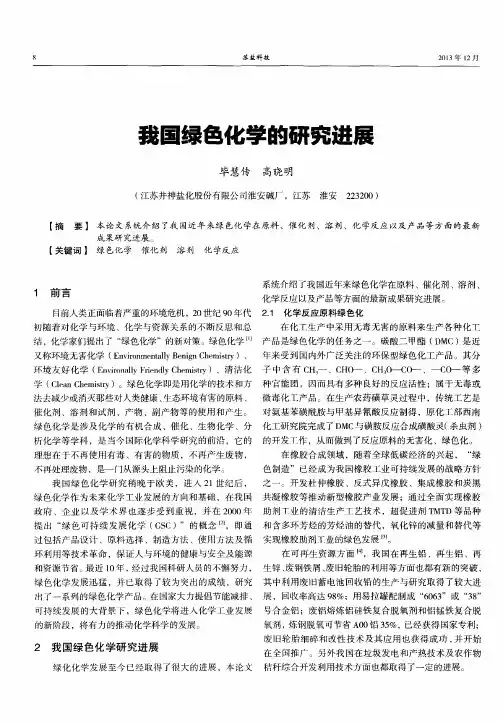

绿色化学化工催化剂研究进展系别:专业名称:学生姓名:学号:指导教师姓名:完成日期 2010年10月17日绿色化学化工催化剂研究进展摘要:对绿色化工中催化剂的研究进展进行了综合叙述,主要介绍了固体酸催化剂、固体碱催化剂和金属催化剂的研究现状,并对其应用和发展前景作了总结和评述.关键词:绿色化工催化剂;同体酸催化剂;同体碱催化剂;金属催化剂Advance in Green Chcmistry CatalystAbstract:Advances in research and development of new-calalyst were reviewed in this paper Researches in solid acid catalyst 、solid base catalyst and metal catalyst and their prospect of application were discussed.Key words: green chemistry catalyst; solid acid catalyst ;solid base catalyst;metal catalyst目录1引言 (1)2 固体酸催化剂的研究进展 (1)2.1金属氧化物催化剂 (1)2.2金属盐催化剂 (1)2.3分子筛 (1)2.4杂多酸催化剂 (2)3 固体碱催化剂的研究进展 (3)4金属催化剂的研究进展 (3)5 结语 (4)参考文献 (4)1引言随着近年地球环境的不断恶化,世界各国日益重视可持续发展战略,绿色化学和化工将给化学工业和环境工程带来革命性变化,要实现环境友好的绿色化工,研究开发新的催化剂及催化方法成为当前关注的重要课题之一。
绿色化工催化剂主要包括固体酸催化剂、固体碱催化剂、金属催化剂等,这些催化剂不仅具有较高活性和选择性,而且催化剂和反应体系易于分离,新型绿色化工催化已成为实现化学工业从低污染向无污染方向转变的关键。
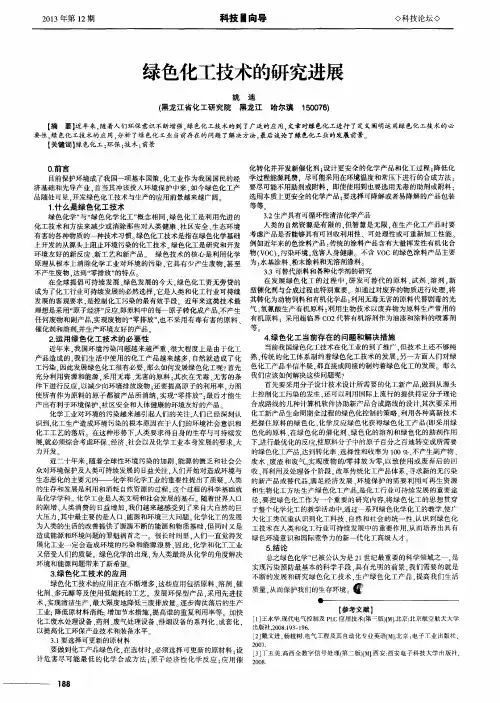
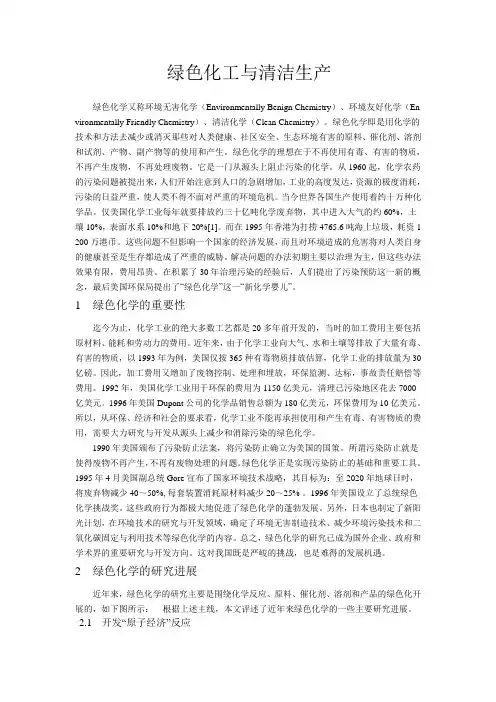
绿色化工与清洁生产绿色化学又称环境无害化学(Environmentally Benign Chemistry)、环境友好化学(En vironmentally Friendly Chemistry)、清洁化学(Clean Chemistry)。
绿色化学即是用化学的技术和方法去减少或消灭那些对人类健康、社区安全、生态环境有害的原料、催化剂、溶剂和试剂、产物、副产物等的使用和产生。
绿色化学的理想在于不再使用有毒、有害的物质,不再产生废物,不再处理废物。
它是一门从源头上阻止污染的化学。
从1960起,化学农药的污染问题被提出来,人们开始注意到人口的急剧增加,工业的高度发达,资源的极度消耗,污染的日益严重,使人类不得不面对严重的环境危机。
当今世界各国生产使用着约十万种化学品。
仅美国化学工业每年就要排放约三十亿吨化学废弃物,其中进入大气的约60%,土壤10%,表面水系10%和地下20%[1]。
而在1995年香港为打捞4765.6吨海上垃圾,耗资1 200万港币。
这些问题不但影响一个国家的经济发展,而且对环境造成的危害将对人类自身的健康甚至是生存都造成了严重的威胁。
解决问题的办法初期主要以治理为主,但这些办法效果有限,费用昂贵。
在积累了30年治理污染的经验后,人们提出了污染预防这一新的概念,最后美国环保局提出了“绿色化学”这一“新化学婴儿”。
1绿色化学的重要性迄今为止,化学工业的绝大多数工艺都是20多年前开发的,当时的加工费用主要包括原材料、能耗和劳动力的费用。
近年来,由于化学工业向大气、水和土壤等排放了大量有毒、有害的物质,以1993年为例,美国仅按365种有毒物质排放估算,化学工业的排放量为30亿磅。
因此,加工费用又增加了废物控制、处理和埋放,环保监测、达标,事故责任赔偿等费用。
1992年,美国化学工业用于环保的费用为1150亿美元,清理已污染地区花去7000亿美元。
1996年美国Dupont公司的化学品销售总额为180亿美元,环保费用为10亿美元。

一、绿色化学化工基本问题的发展及研究进展1984 年美国环保局首先提出“废物最小化”,初步体现绿色化学的思想。
而到1989 年美国环保局提出“污染预防”——绿色化学思想才初步形成,1990 年美国联邦政府通过“防止污染行动”的法令,将污染的防止确立为国策之后,才第一次出现“绿色化学”这个词汇。
尽管这个词出现至今已近17年,但其含义,也即其定义却也在不断的发展和变化。
刚出现时,它更多的是代表一种理念、一种愿望。
但随着时间的流逝,它本身在不断的发展变化中逐步趋于实际应用,且其发展与化工密切相关。
实际上,绿色化学代表了化学和化工学科的共同发展趋势和目标之一,即无论是化学还是化工,不仅要面对社会发展对环境、健康和能源等方面日益严格的要求,而且还要面临来自其他新兴学科前所未有的挑战。
而绿色化学在连接化学与化工中所起的桥梁作用就体现得越来越明显。
二、绿色化学和化工的发展趋势按照技术领域作者提出了绿色化工产品设计、新型反应技术、溶剂的绿色化及绿色溶剂等几个方面绿色化学和化工的发展趋势。
1.绿色化工产品设计绿色化工产品设计要求对环境的影响最小化,这包括设计过程中的生命周期分析和循环回收、回用设计等。
如果一个产品本身对环境有害,仅仅降低其成本和改进其生产工艺对环境的影响是不够的,化学工业需要思考更多的是产品全生命周期中的成本和收益,特别是要考虑社会和环境的成本。
因此,国家在这方面的法律法规对于产品设计的绿色化具有很大的影响。
其中发达国家对于化工产品“绿色化”的要求,以及发展中国家受到“绿色壁垒”的限制,使得化工产品设计的绿色化成为必然趋势。
在绿色化工产品设计时,要遵循全生命周期设计、再循环和再使用设计、降低原料和能量消耗设计以及利用计算机技术进行绿色化工产品的设计等原则。
由于大多数人只考虑到他们直接控制的产品生命周期部分,造成化工产品全生命周期的想法尚不能深入化学工业界。
另外,化工产品设计的绿色化并没有成为企业发展的机遇,而更多的是企业被大环境所逼而致的。
绿色合成化学研究进展随着全球环保意识的提高,绿色化学也逐渐受到了广泛关注。
绿色化学是指在化学合成中,优先从绿色环保的角度考虑,尽量不使用有害物质,不产生有害物质和废物,从而实现高效、可持续、环境友好的实验过程。
而绿色合成化学则是绿色化学的重要分支之一,它研究的是通过环境友好的方法合成新化合物,并提高其合成效率,不产生废物,减少污染。
目前,绿色合成化学已成为有机合成化学研究的热点之一。
研究者们通过不断探索和实验,不断开发绿色合成的新方法和新技术,推动着绿色合成化学的发展。
在这篇文章中,我们将介绍绿色合成化学方面的一些进展。
1. 微波辅助合成技术微波辅助合成技术是一种常用的绿色合成化学方法。
它通过微波辐射的加热作用使反应溶液在短时间内达到高温状态,从而促进反应速率,降低反应温度和反应时间。
与传统合成方法相比,微波辅助合成技术具有反应速率快、温度低、耗能少等优点。
因此,微波辅助合成技术已被广泛运用于有机合成、材料合成和生物医药领域。
2. 催化剂的开发和研究催化剂是绿色合成化学的核心之一。
它能够在反应过程中加速反应速率、提高反应选择性和降低反应温度。
研究人员通过不断地开发和研究新型催化剂,有效地实现了绿色合成化学的重大突破。
目前,研究人员已经开发了一系列各种各样的催化剂,其中一些催化剂在绿色合成化学中的研究得到了广泛应用。
比如;金属有机框架催化剂、离子液体催化剂、生物催化剂等等。
这些催化剂不仅具有高效、选择性好、廉价,而且能够回收利用,大大减少了废弃物的产生,达成了绿色合成的目的。
3. 可再生资源的应用可再生资源的应用是绿色合成化学的另一个重要研究方向,它主要通过利用可再生资源替代传统的合成原料,比如石油和天然气,从而减少对可再生资源的消耗,降低清洁能源的成本。
在可再生资源的应用方面,生物质固体酸催化技术和生物质热解技术都是比较成熟和广泛应用的方法。
生物质固体酸催化技术主要是有机废弃物的降解和转化,而生物质热解技术则是利用热能将生物质转化为化工原料。